Hyundai Accent 2009 Workshop Manual
Manufacturer: HYUNDAI, Model Year: 2009, Model line: Accent, Model: Hyundai Accent 2009Pages: 266, PDF Size: 8.77 MB
Page 51 of 266
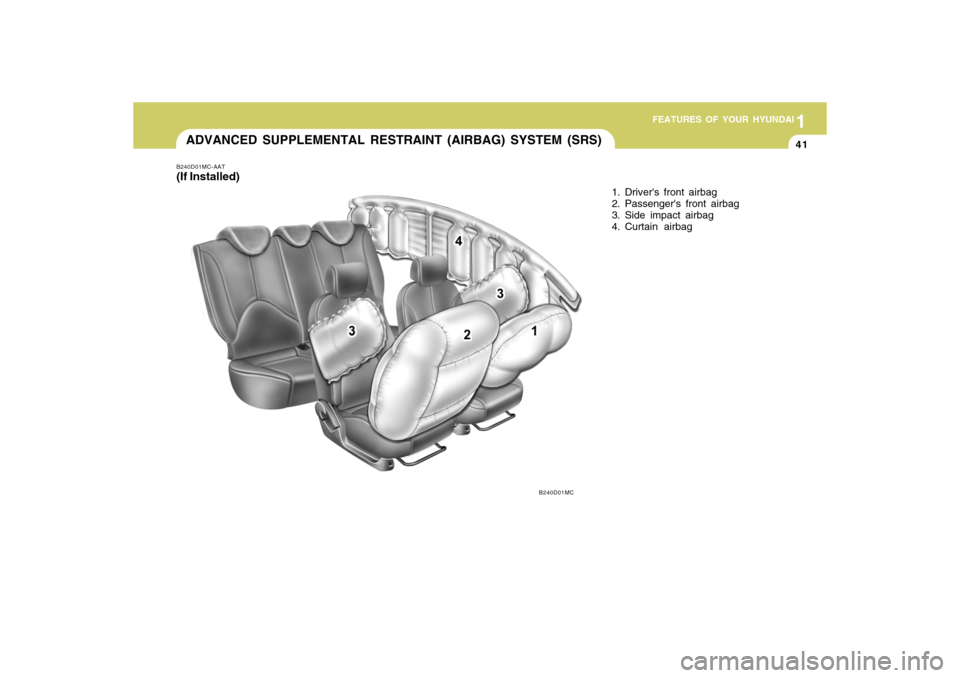
1
FEATURES OF YOUR HYUNDAI
411
FEATURES OF YOUR HYUNDAI
41
B240D01MC-AAT(If Installed)ADVANCED SUPPLEMENTAL RESTRAINT (AIRBAG) SYSTEM (SRS)
1. Driver's front airbag
2. Passenger's front airbag
3. Side impact airbag
4. Curtain airbag
B240D01MC
Page 52 of 266
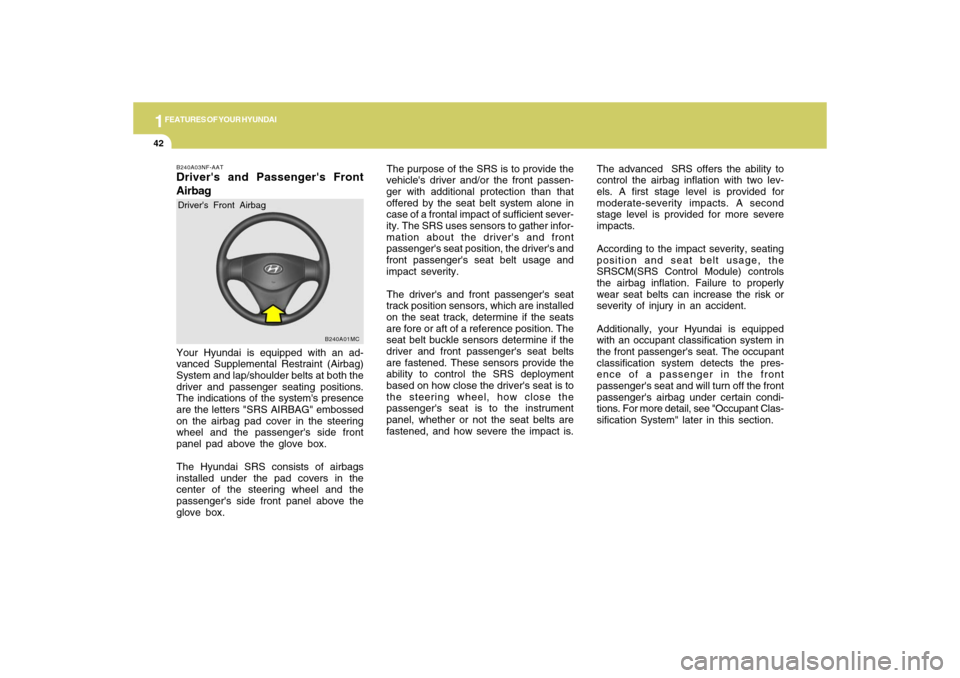
1FEATURES OF YOUR HYUNDAI42
B240A01MC
The purpose of the SRS is to provide the
vehicle's driver and/or the front passen-
ger with additional protection than that
offered by the seat belt system alone in
case of a frontal impact of sufficient sever-
ity. The SRS uses sensors to gather infor-
mation about the driver's and front
passenger's seat position, the driver's and
front passenger's seat belt usage and
impact severity.
The driver's and front passenger's seat
track position sensors, which are installed
on the seat track, determine if the seats
are fore or aft of a reference position. The
seat belt buckle sensors determine if the
driver and front passenger's seat belts
are fastened. These sensors provide the
ability to control the SRS deployment
based on how close the driver's seat is to
the steering wheel, how close the
passenger's seat is to the instrument
panel, whether or not the seat belts are
fastened, and how severe the impact is.The advanced SRS offers the ability to
control the airbag inflation with two lev-
els. A first stage level is provided for
moderate-severity impacts. A second
stage level is provided for more severe
impacts.
According to the impact severity, seating
position and seat belt usage, the
SRSCM(SRS Control Module) controls
the airbag inflation. Failure to properly
wear seat belts can increase the risk or
severity of injury in an accident.
Additionally, your Hyundai is equipped
with an occupant classification system in
the front passenger's seat. The occupant
classification system detects the pres-
ence of a passenger in the front
passenger's seat and will turn off the front
passenger's airbag under certain condi-
tions. For more detail, see "Occupant Clas-
sification System" later in this section.
B240A03NF-AATDriver's and Passenger's Front
AirbagYour Hyundai is equipped with an ad-
vanced Supplemental Restraint (Airbag)
System and lap/shoulder belts at both the
driver and passenger seating positions.
The indications of the system's presence
are the letters "SRS AIRBAG" embossed
on the airbag pad cover in the steering
wheel and the passenger's side front
panel pad above the glove box.
The Hyundai SRS consists of airbags
installed under the pad covers in the
center of the steering wheel and the
passenger's side front panel above the
glove box.Driver's Front Airbag
Page 53 of 266
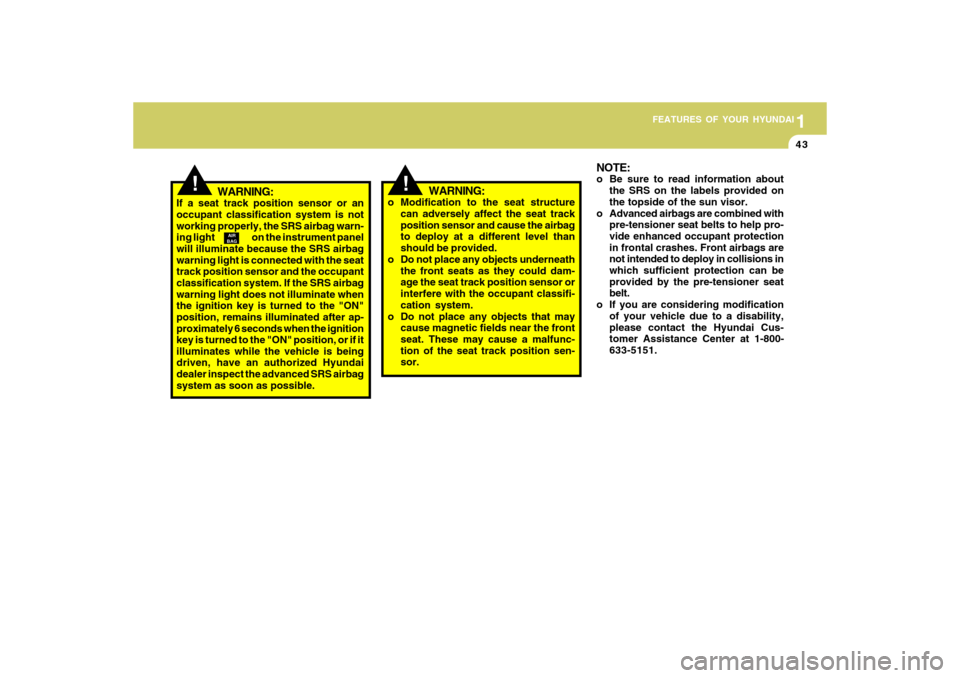
1
FEATURES OF YOUR HYUNDAI
431
FEATURES OF YOUR HYUNDAI
43
!
WARNING:
If a seat track position sensor or an
occupant classification system is not
working properly, the SRS airbag warn-
ing light on the instrument panel
will illuminate because the SRS airbag
warning light is connected with the seat
track position sensor and the occupant
classification system. If the SRS airbag
warning light does not illuminate when
the ignition key is turned to the "ON"
position, remains illuminated after ap-
proximately 6 seconds when the ignition
key is turned to the "ON" position, or if it
illuminates while the vehicle is being
driven, have an authorized Hyundai
dealer inspect the advanced SRS airbag
system as soon as possible.
AIR
BAG
!
WARNING:
o Modification to the seat structure
can adversely affect the seat track
position sensor and cause the airbag
to deploy at a different level than
should be provided.
o Do not place any objects underneath
the front seats as they could dam-
age the seat track position sensor or
interfere with the occupant classifi-
cation system.
o Do not place any objects that may
cause magnetic fields near the front
seat. These may cause a malfunc-
tion of the seat track position sen-
sor.
NOTE:o Be sure to read information about
the SRS on the labels provided on
the topside of the sun visor.
o Advanced airbags are combined with
pre-tensioner seat belts to help pro-
vide enhanced occupant protection
in frontal crashes. Front airbags are
not intended to deploy in collisions in
which sufficient protection can be
provided by the pre-tensioner seat
belt.
o If you are considering modification
of your vehicle due to a disability,
please contact the Hyundai Cus-
tomer Assistance Center at 1-800-
633-5151.
Page 54 of 266
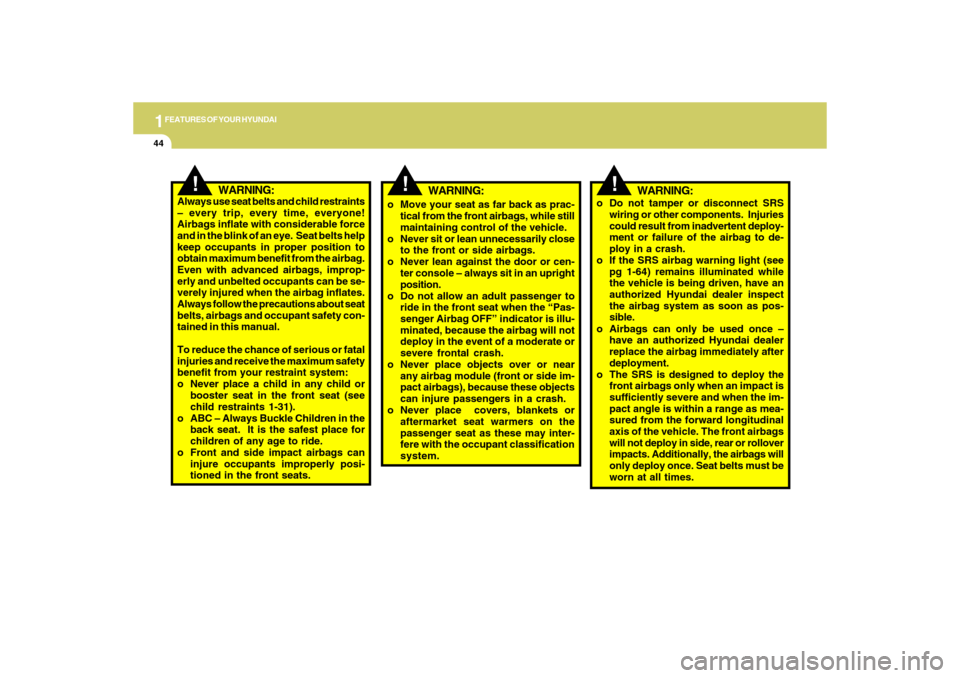
1FEATURES OF YOUR HYUNDAI44
!
WARNING:
o Move your seat as far back as prac-
tical from the front airbags, while still
maintaining control of the vehicle.
o Never sit or lean unnecessarily close
to the front or side airbags.
o Never lean against the door or cen-
ter console – always sit in an upright
position.
o Do not allow an adult passenger to
ride in the front seat when the “Pas-
senger Airbag OFF” indicator is illu-
minated, because the airbag will not
deploy in the event of a moderate or
severe frontal crash.
o Never place objects over or near
any airbag module (front or side im-
pact airbags), because these objects
can injure passengers in a crash.
o Never place covers, blankets or
aftermarket seat warmers on the
passenger seat as these may inter-
fere with the occupant classification
system.
!
WARNING:
Always use seat belts and child restraints
– every trip, every time, everyone!
Airbags inflate with considerable force
and in the blink of an eye. Seat belts help
keep occupants in proper position to
obtain maximum benefit from the airbag.
Even with advanced airbags, improp-
erly and unbelted occupants can be se-
verely injured when the airbag inflates.
Always follow the precautions about seat
belts, airbags and occupant safety con-
tained in this manual.
To reduce the chance of serious or fatal
injuries and receive the maximum safety
benefit from your restraint system:
o Never place a child in any child or
booster seat in the front seat (see
child restraints 1-31).
o ABC – Always Buckle Children in the
back seat. It is the safest place for
children of any age to ride.
o Front and side impact airbags can
injure occupants improperly posi-
tioned in the front seats.
!
WARNING:
o Do not tamper or disconnect SRS
wiring or other components. Injuries
could result from inadvertent deploy-
ment or failure of the airbag to de-
ploy in a crash.
o If the SRS airbag warning light (see
pg 1-64) remains illuminated while
the vehicle is being driven, have an
authorized Hyundai dealer inspect
the airbag system as soon as pos-
sible.
o Airbags can only be used once –
have an authorized Hyundai dealer
replace the airbag immediately after
deployment.
o The SRS is designed to deploy the
front airbags only when an impact is
sufficiently severe and when the im-
pact angle is within a range as mea-
sured from the forward longitudinal
axis of the vehicle. The front airbags
will not deploy in side, rear or rollover
impacts. Additionally, the airbags will
only deploy once. Seat belts must be
worn at all times.
Page 55 of 266
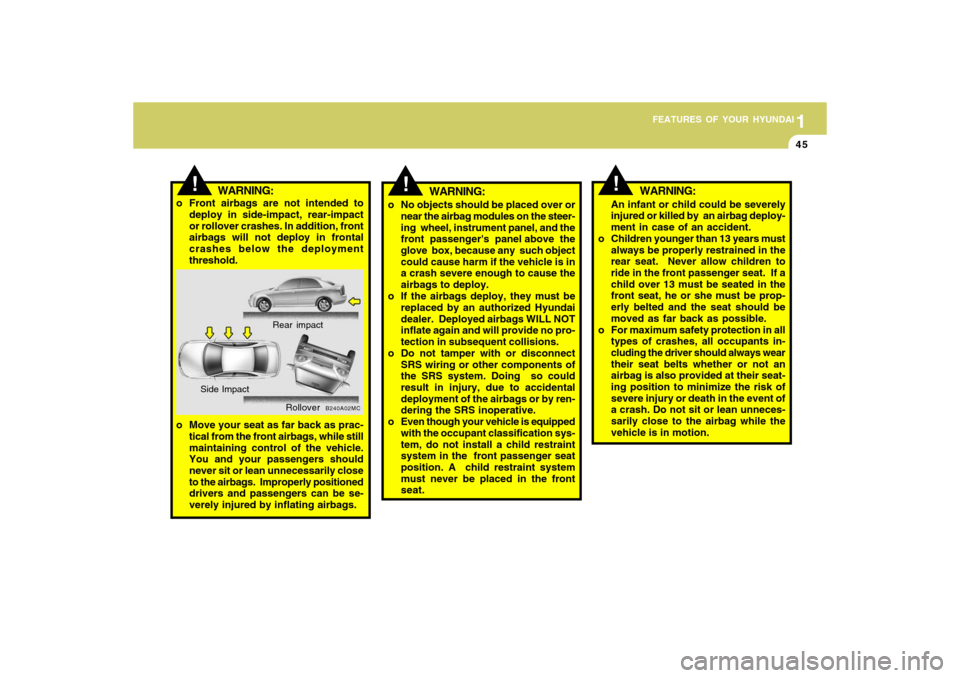
1
FEATURES OF YOUR HYUNDAI
451
FEATURES OF YOUR HYUNDAI
45
!
WARNING:
o No objects should be placed over or
near the airbag modules on the steer-
ing wheel, instrument panel, and the
front passenger's panel above the
glove box, because any such object
could cause harm if the vehicle is in
a crash severe enough to cause the
airbags to deploy.
o If the airbags deploy, they must be
replaced by an authorized Hyundai
dealer. Deployed airbags WILL NOT
inflate again and will provide no pro-
tection in subsequent collisions.
o Do not tamper with or disconnect
SRS wiring or other components of
the SRS system. Doing so could
result in injury, due to accidental
deployment of the airbags or by ren-
dering the SRS inoperative.
o Even though your vehicle is equipped
with the occupant classification sys-
tem, do not install a child restraint
system in the front passenger seat
position. A child restraint system
must never be placed in the front
seat.
An infant or child could be severely
injured or killed by an airbag deploy-
ment in case of an accident.
o Children younger than 13 years must
always be properly restrained in the
rear seat. Never allow children to
ride in the front passenger seat. If a
child over 13 must be seated in the
front seat, he or she must be prop-
erly belted and the seat should be
moved as far back as possible.
o For maximum safety protection in all
types of crashes, all occupants in-
cluding the driver should always wear
their seat belts whether or not an
airbag is also provided at their seat-
ing position to minimize the risk of
severe injury or death in the event of
a crash. Do not sit or lean unneces-
sarily close to the airbag while the
vehicle is in motion.!
WARNING:
!
WARNING:
B240A02MC
Rear impact
Side Impact
Rollover
o Front airbags are not intended to
deploy in side-impact, rear-impact
or rollover crashes. In addition, front
airbags will not deploy in frontal
crashes below the deployment
threshold.
o Move your seat as far back as prac-
tical from the front airbags, while still
maintaining control of the vehicle.
You and your passengers should
never sit or lean unnecessarily close
to the airbags. Improperly positioned
drivers and passengers can be se-
verely injured by inflating airbags.
Page 56 of 266
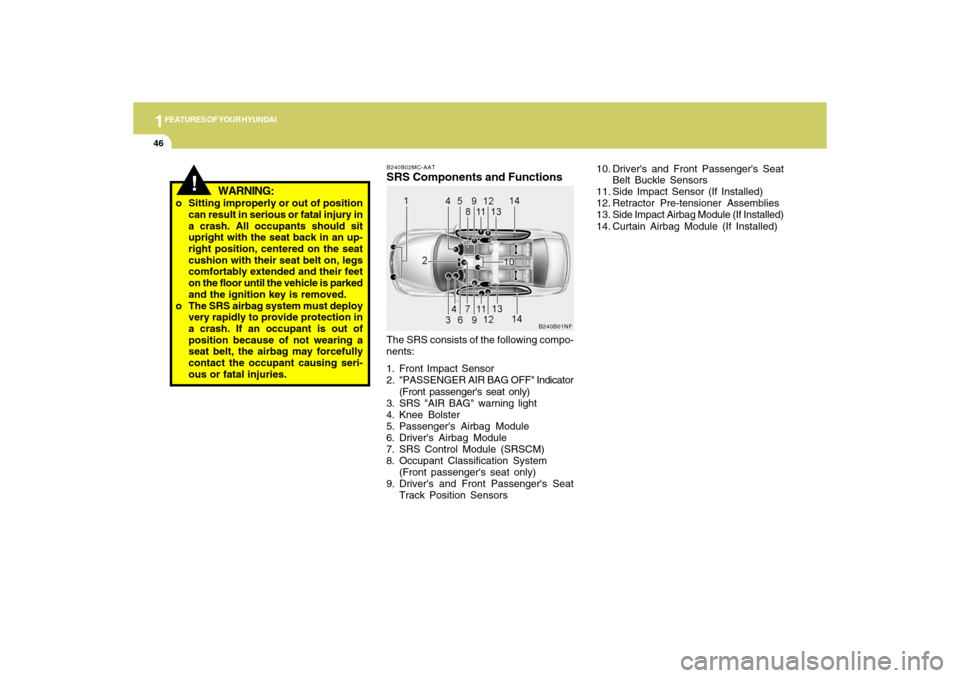
1FEATURES OF YOUR HYUNDAI46
B240B02MC-AATSRS Components and FunctionsThe SRS consists of the following compo-
nents:
1. Front Impact Sensor
2. "PASSENGER AIR BAG OFF" Indicator
(Front passenger's seat only)
3. SRS "AIR BAG" warning light
4. Knee Bolster
5. Passenger's Airbag Module
6. Driver's Airbag Module
7. SRS Control Module (SRSCM)
8. Occupant Classification System
(Front passenger's seat only)
9. Driver's and Front Passenger's Seat
Track Position Sensors
B240B01NF
10. Driver's and Front Passenger's Seat
Belt Buckle Sensors
11. Side Impact Sensor (If Installed)
12. Retractor Pre-tensioner Assemblies
13. Side Impact Airbag Module (If Installed)
14. Curtain Airbag Module (If Installed)
!
WARNING:
o Sitting improperly or out of position
can result in serious or fatal injury in
a crash. All occupants should sit
upright with the seat back in an up-
right position, centered on the seat
cushion with their seat belt on, legs
comfortably extended and their feet
on the floor until the vehicle is parked
and the ignition key is removed.
o The SRS airbag system must deploy
very rapidly to provide protection in
a crash. If an occupant is out of
position because of not wearing a
seat belt, the airbag may forcefully
contact the occupant causing seri-
ous or fatal injuries.
Page 57 of 266
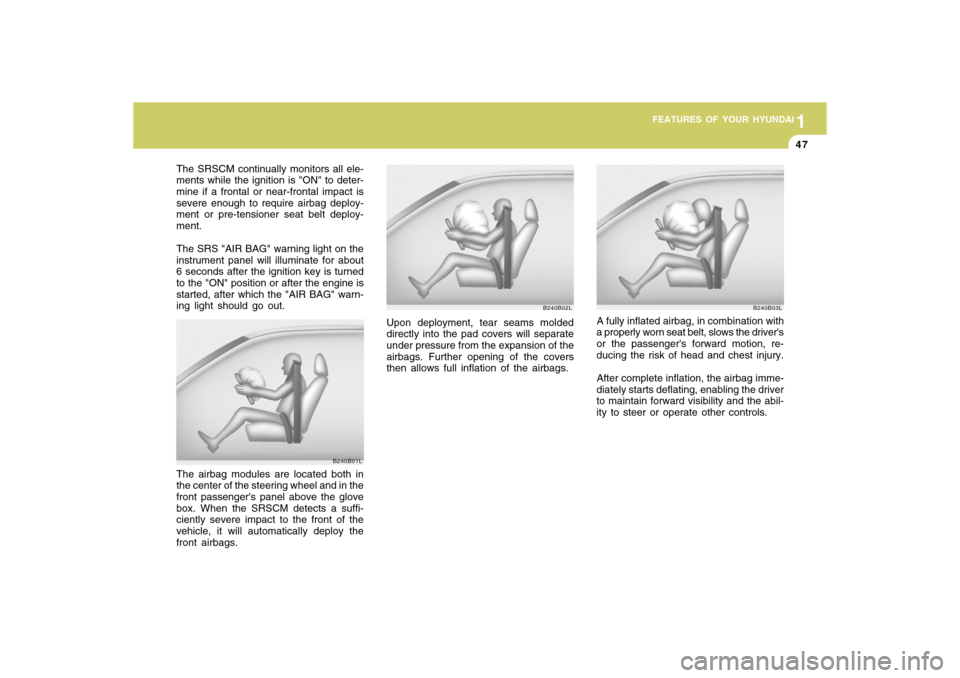
1
FEATURES OF YOUR HYUNDAI
471
FEATURES OF YOUR HYUNDAI
47
The SRSCM continually monitors all ele-
ments while the ignition is "ON" to deter-
mine if a frontal or near-frontal impact is
severe enough to require airbag deploy-
ment or pre-tensioner seat belt deploy-
ment.
The SRS "AIR BAG" warning light on the
instrument panel will illuminate for about
6 seconds after the ignition key is turned
to the "ON" position or after the engine is
started, after which the "AIR BAG" warn-
ing light should go out.
B240B01L
Upon deployment, tear seams molded
directly into the pad covers will separate
under pressure from the expansion of the
airbags. Further opening of the covers
then allows full inflation of the airbags.
The airbag modules are located both in
the center of the steering wheel and in the
front passenger's panel above the glove
box. When the SRSCM detects a suffi-
ciently severe impact to the front of the
vehicle, it will automatically deploy the
front airbags.
B240B02L
A fully inflated airbag, in combination with
a properly worn seat belt, slows the driver's
or the passenger's forward motion, re-
ducing the risk of head and chest injury.
After complete inflation, the airbag imme-
diately starts deflating, enabling the driver
to maintain forward visibility and the abil-
ity to steer or operate other controls.
B240B03L
Page 58 of 266
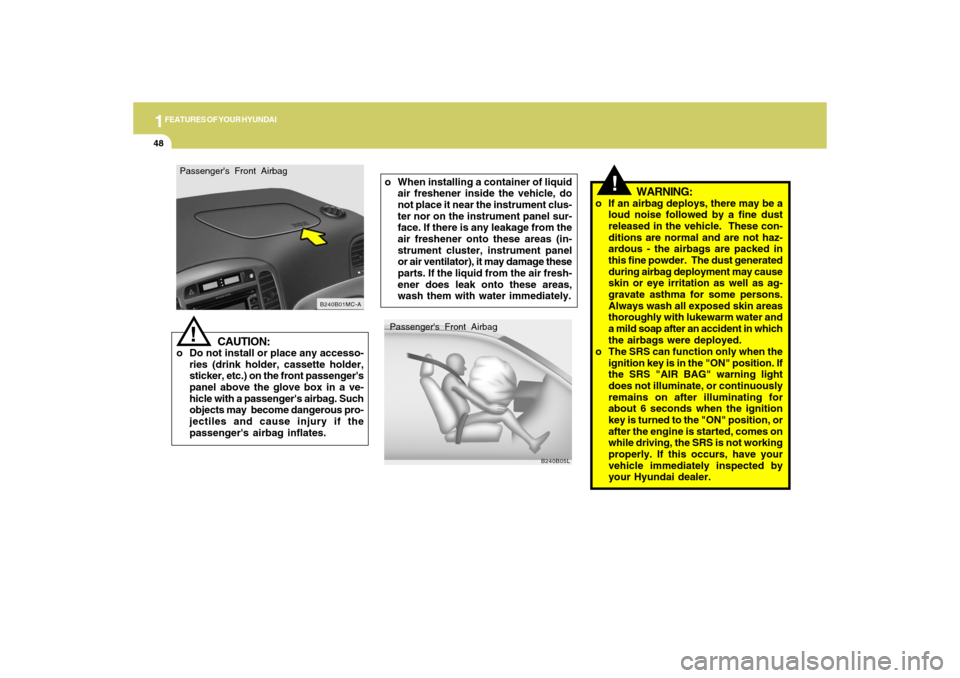
1FEATURES OF YOUR HYUNDAI48
!
Passenger's Front Airbag
B240B05L
o When installing a container of liquid
air freshener inside the vehicle, do
not place it near the instrument clus-
ter nor on the instrument panel sur-
face. If there is any leakage from the
air freshener onto these areas (in-
strument cluster, instrument panel
or air ventilator), it may damage these
parts. If the liquid from the air fresh-
ener does leak onto these areas,
wash them with water immediately.
WARNING:
o If an airbag deploys, there may be a
loud noise followed by a fine dust
released in the vehicle. These con-
ditions are normal and are not haz-
ardous - the airbags are packed in
this fine powder. The dust generated
during airbag deployment may cause
skin or eye irritation as well as ag-
gravate asthma for some persons.
Always wash all exposed skin areas
thoroughly with lukewarm water and
a mild soap after an accident in which
the airbags were deployed.
o The SRS can function only when the
ignition key is in the "ON" position. If
the SRS "AIR BAG" warning light
does not illuminate, or continuously
remains on after illuminating for
about 6 seconds when the ignition
key is turned to the "ON" position, or
after the engine is started, comes on
while driving, the SRS is not working
properly. If this occurs, have your
vehicle immediately inspected by
your Hyundai dealer.
Passenger's Front Airbag
CAUTION:
o Do not install or place any accesso-
ries (drink holder, cassette holder,
sticker, etc.) on the front passenger's
panel above the glove box in a ve-
hicle with a passenger's airbag. Such
objects may become dangerous pro-
jectiles and cause injury if the
passenger's airbag inflates.
!
B240B01MC-A
Page 59 of 266
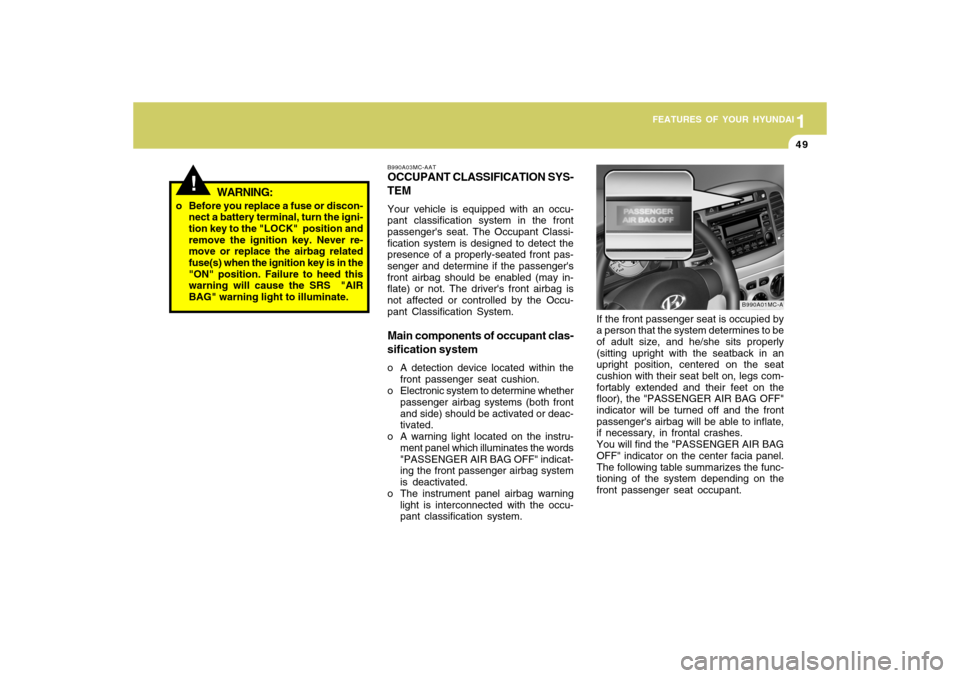
1
FEATURES OF YOUR HYUNDAI
491
FEATURES OF YOUR HYUNDAI
49
!
o Before you replace a fuse or discon-
nect a battery terminal, turn the igni-
tion key to the "LOCK" position and
remove the ignition key. Never re-
move or replace the airbag related
fuse(s) when the ignition key is in the
"ON" position. Failure to heed this
warning will cause the SRS "AIR
BAG" warning light to illuminate.
WARNING:
If the front passenger seat is occupied by
a person that the system determines to be
of adult size, and he/she sits properly
(sitting upright with the seatback in an
upright position, centered on the seat
cushion with their seat belt on, legs com-
fortably extended and their feet on the
floor), the "PASSENGER AIR BAG OFF"
indicator will be turned off and the front
passenger's airbag will be able to inflate,
if necessary, in frontal crashes.
You will find the "PASSENGER AIR BAG
OFF" indicator on the center facia panel.
The following table summarizes the func-
tioning of the system depending on the
front passenger seat occupant.
B990A01MC-A B990A03MC-AAT
OCCUPANT CLASSIFICATION SYS-
TEMYour vehicle is equipped with an occu-
pant classification system in the front
passenger's seat. The Occupant Classi-
fication system is designed to detect the
presence of a properly-seated front pas-
senger and determine if the passenger's
front airbag should be enabled (may in-
flate) or not. The driver's front airbag is
not affected or controlled by the Occu-
pant Classification System.Main components of occupant clas-
sification systemo A detection device located within the
front passenger seat cushion.
o Electronic system to determine whether
passenger airbag systems (both front
and side) should be activated or deac-
tivated.
o A warning light located on the instru-
ment panel which illuminates the words
"PASSENGER AIR BAG OFF" indicat-
ing the front passenger airbag system
is deactivated.
o The instrument panel airbag warning
light is interconnected with the occu-
pant classification system.
Page 60 of 266
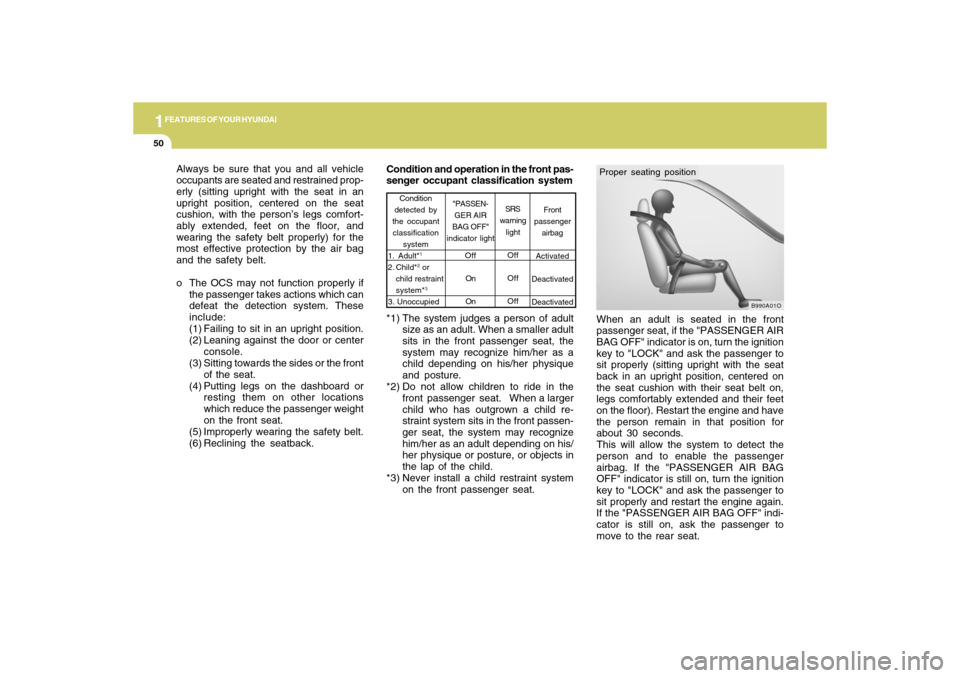
1FEATURES OF YOUR HYUNDAI50
When an adult is seated in the front
passenger seat, if the "PASSENGER AIR
BAG OFF" indicator is on, turn the ignition
key to "LOCK" and ask the passenger to
sit properly (sitting upright with the seat
back in an upright position, centered on
the seat cushion with their seat belt on,
legs comfortably extended and their feet
on the floor). Restart the engine and have
the person remain in that position for
about 30 seconds.
This will allow the system to detect the
person and to enable the passenger
airbag. If the "PASSENGER AIR BAG
OFF" indicator is still on, turn the ignition
key to "LOCK" and ask the passenger to
sit properly and restart the engine again.
If the "PASSENGER AIR BAG OFF" indi-
cator is still on, ask the passenger to
move to the rear seat.Proper seating position
B990A01O
*1) The system judges a person of adult
size as an adult. When a smaller adult
sits in the front passenger seat, the
system may recognize him/her as a
child depending on his/her physique
and posture.
*2) Do not allow children to ride in the
front passenger seat. When a larger
child who has outgrown a child re-
straint system sits in the front passen-
ger seat, the system may recognize
him/her as an adult depending on his/
her physique or posture, or objects in
the lap of the child.
*3) Never install a child restraint system
on the front passenger seat. Condition and operation in the front pas-
senger occupant classification system
Front
passenger
airbag
Activated
Deactivated
Deactivated Condition
detected by
the occupant
classification
system
1. Adult*
1
2. Child*
2 or
child restraint
system*3
3. UnoccupiedSRS
warning
light
Off
Off
Off "PASSEN-
GER AIR
BAG OFF"
indicator light
Off
On
On
Always be sure that you and all vehicle
occupants are seated and restrained prop-
erly (sitting upright with the seat in an
upright position, centered on the seat
cushion, with the person’s legs comfort-
ably extended, feet on the floor, and
wearing the safety belt properly) for the
most effective protection by the air bag
and the safety belt.
o The OCS may not function properly if
the passenger takes actions which can
defeat the detection system. These
include:
(1) Failing to sit in an upright position.
(2) Leaning against the door or center
console.
(3) Sitting towards the sides or the front
of the seat.
(4) Putting legs on the dashboard or
resting them on other locations
which reduce the passenger weight
on the front seat.
(5) Improperly wearing the safety belt.
(6) Reclining the seatback.